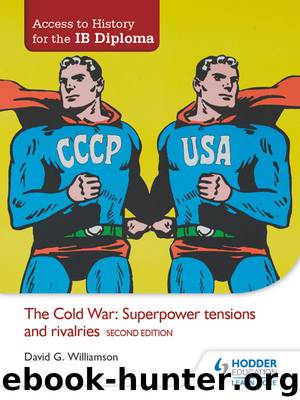Access to History for the IB Diploma: The Cold War: Superpower tensions and rivalries Second Edition by David Williamson

Author:David Williamson [Williamson, David]
Language: eng
Format: azw3
ISBN: 9781471839252
Publisher: Hodder Education
Published: 2015-05-15T04:00:00+00:00
PRC soldiers patrolling on Zhenbao Island, March 1969.
SUMMARY DIAGRAM
The Sino-Soviet split
The impact of Mao Zedong on the course and development of the Cold War
1883 Born
1921 Attended National Congress of CCP
1934–35 The Long March
1943 Became Chairman of CCP
1949 Civil war in China ended with Mao’s victory
1950 February Sino-Soviet Pact
1950 October PRC troops assist North Korea
1954 Became President of PRC
1957 Launched the Great Leap Forward campaign
1959 Sino-Soviet split
1966–76 Unleashed the Cultural Revolution
1972 US President Nixon visited Beijing
1976 Death
Mao’s impact on the Cold War was immense. Not only did he lead communism to power in China, but by doing so he created an alternative to Stalinism and the Soviet variant of Marxist–Leninism. Under his leadership the CCP escaped annihilation at the hands of the KMT. By late 1944 it was an effective fighting force, ultimately able to resist pressure from both the USSR and US to make peace with the KMT (see page 104). Consequently, when war broke out again with the KMT in 1946, Mao was able to survive Chiang’s initial attacks, and drove the KMT out of China into Taiwan (see page 108). By winning the Chinese Civil War he ensured that communism would control the largest state in the developing world.
Mao looked to Stalin as the leader of world communism. In February 1950 the Sino-Soviet Pact ensured that the USSR would support the PRC in the event of an attack by the US (see page 109). When the Korean War broke out and US forces neared the Manchurian border in October 1950, Stalin urged the PRC to intervene; Mao would only do so once it was clear that the USSR would offer equipment and air defence, for which the PRC had to pay (see pages 116 and 119). This war had a significant impact on the course of the Cold War. Stalin’s opportunism and reluctance to be dragged into war with the US intensified Mao’s reservations about the USSR (see page 119). It also enabled Mao to turn Chinese public opinion against the US and accelerate land reform, which was a major part of the PRC’s programme, despite the fact that Stalin felt that such a reform was premature given the state of China’s economy. Mao also assisted the Viet Minh’s struggle against the French, 1949–54, but at the Geneva Conference, wishing to avoid another military confrontation with the US so soon after Korea, he was ready to accept the division of Vietnam on the grounds that unity would later be possible (see page 127).
Fuelled by a growing distrust of Stalin’s successors and a determination to mobilize the revolutionary potential of the PRC, Mao built up the PRC to become a major communist rival to the USSR. Mao distrusted Khrushchev and later Brezhnev, calling them ‘revisionists’ who had effectively abandoned the struggle with the US (see pages 165–168). Thus during the Vietnam War, the PRC, rather than co-operating with the USSR to help defeat the US, actively competed with it to be seen by the Non-Aligned Movement as the major source of help (see pages 193–197).
Download
This site does not store any files on its server. We only index and link to content provided by other sites. Please contact the content providers to delete copyright contents if any and email us, we'll remove relevant links or contents immediately.
Talking to Strangers by Malcolm Gladwell(13232)
The Compound Effect by Darren Hardy(8818)
Tools of Titans by Timothy Ferriss(8225)
Wonder by R. J. Palacio(8014)
The Lover by Duras Marguerite(7834)
A Court of Wings and Ruin by Sarah J. Maas(7654)
The Circle by Dave Eggers(7039)
Deep Work by Cal Newport(6888)
Kaplan MCAT General Chemistry Review by Kaplan(6868)
To All the Boys I've Loved Before by Jenny Han(5777)
Wiseguy by Nicholas Pileggi(5674)
The Body: A Guide for Occupants by Bill Bryson(4978)
1,001 ASVAB Practice Questions For Dummies by Powers Rod(4453)
Eat That Frog! by Brian Tracy(4438)
Cracking the GRE Premium Edition with 6 Practice Tests, 2015 (Graduate School Test Preparation) by Princeton Review(4227)
Pre-Suasion: A Revolutionary Way to Influence and Persuade by Robert Cialdini(4153)
Barron's AP Biology by Goldberg M.S. Deborah T(4100)
ACT Math For Dummies by Zegarelli Mark(3996)
Alive: The Story of the Andes Survivors by Piers Paul Read(3970)
